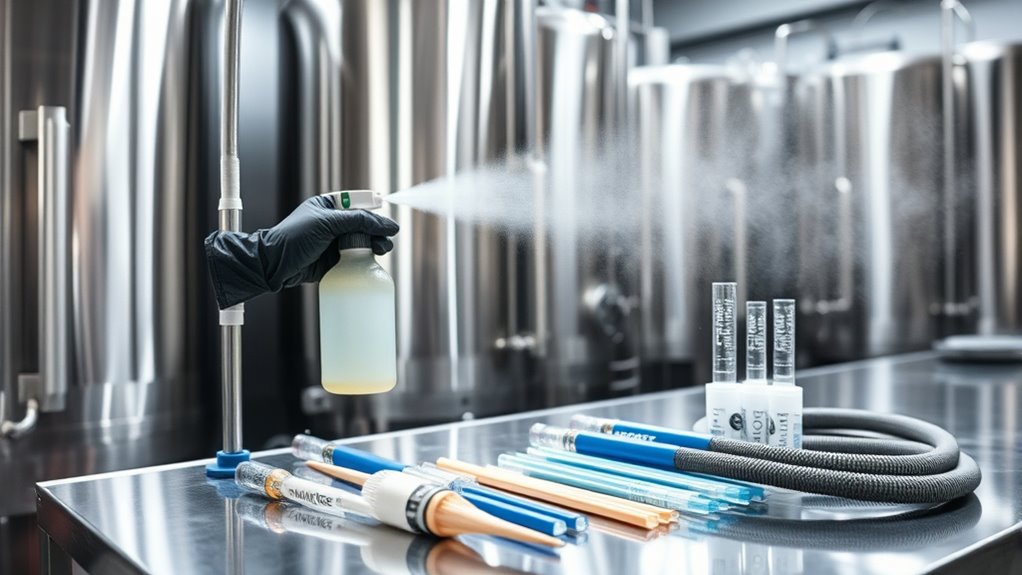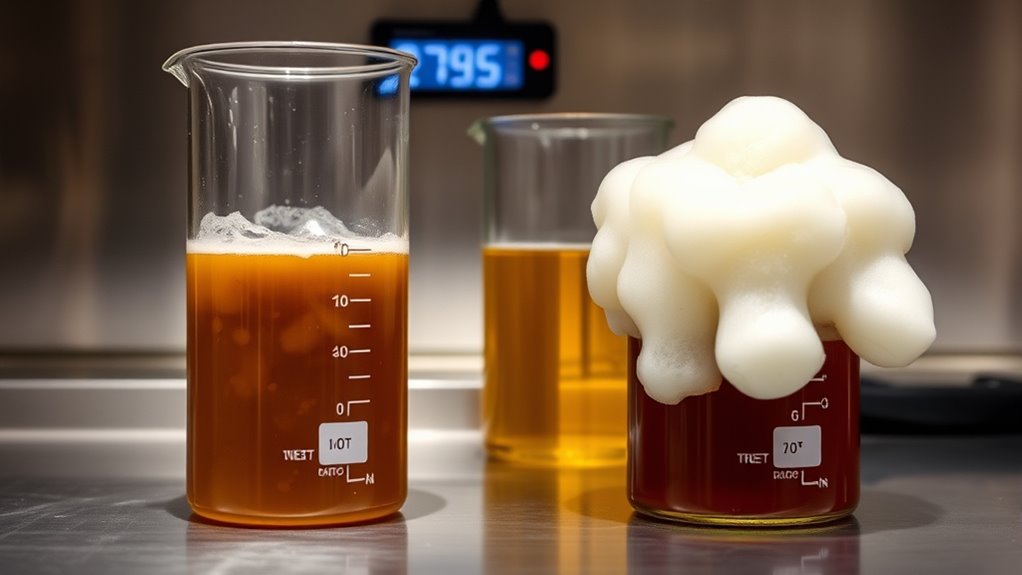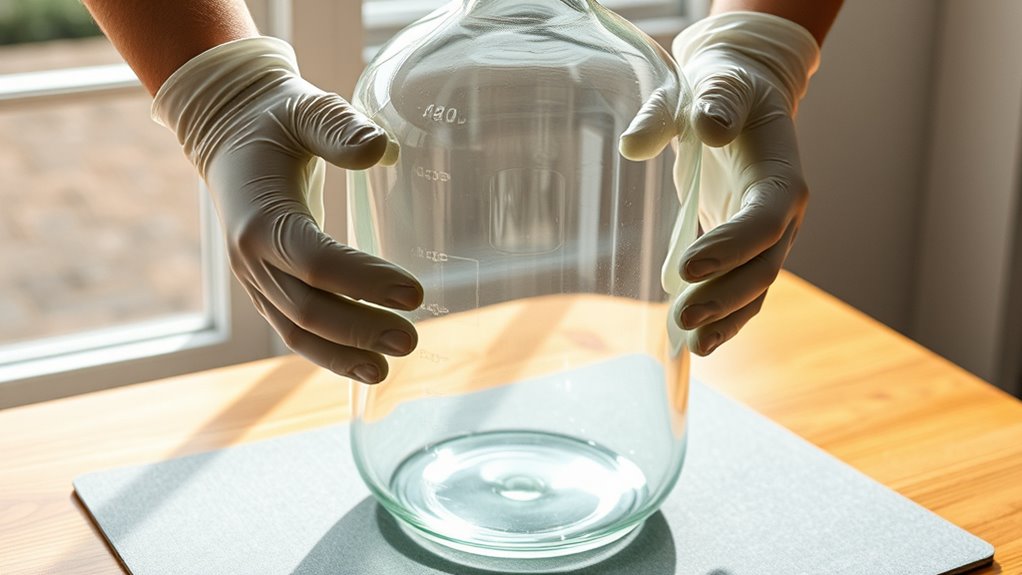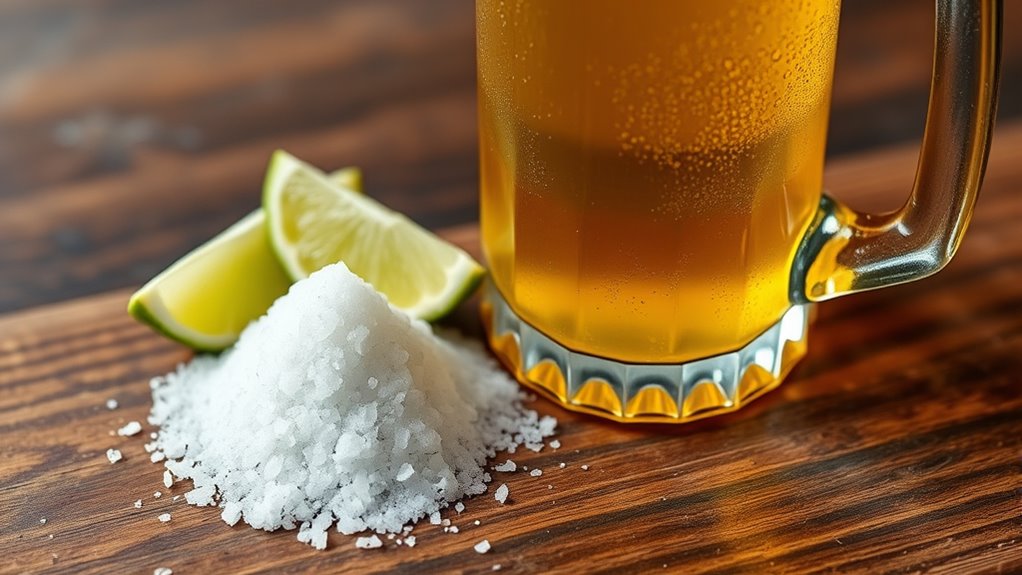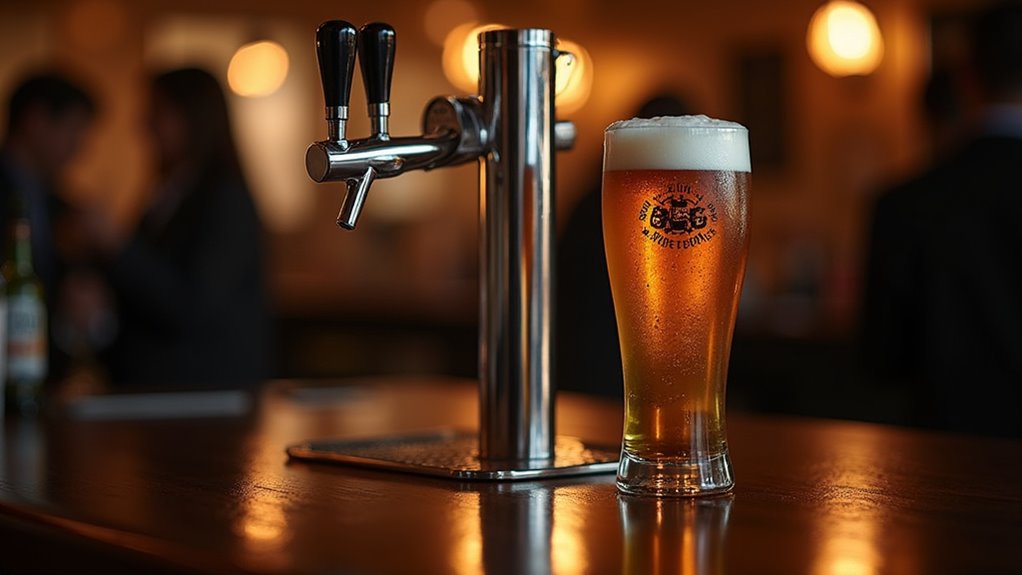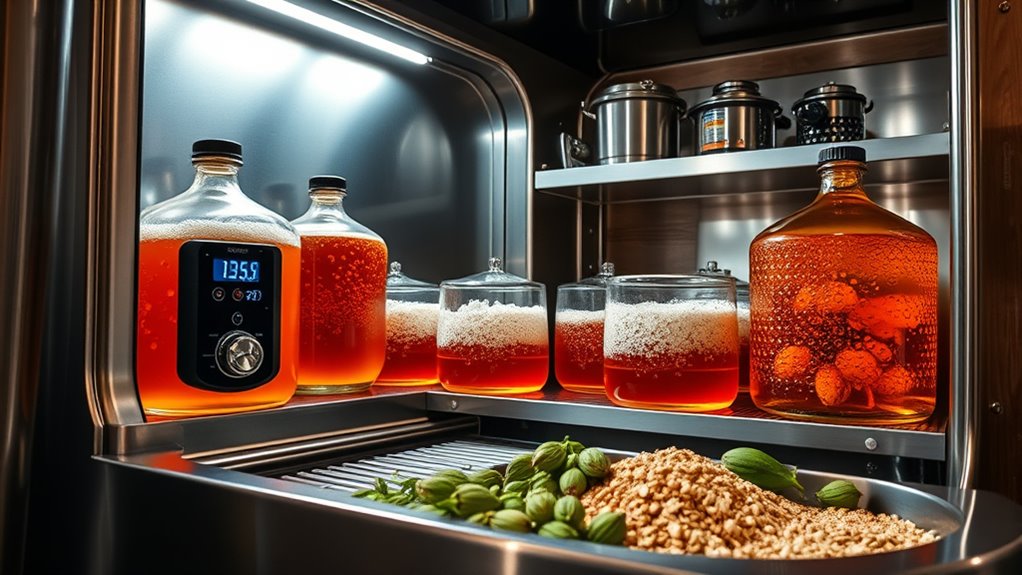To sanitize your brewing equipment and prevent beer contamination, start by cleaning all surfaces with soap and hot water to remove visible debris. After cleaning, use a no-rinse sanitizer like Star San, diluting it as directed, and fully submerge equipment for 1-2 minutes. Make sure to sanitize all items that touch your beer. Always clean immediately after brewing, and store sanitized equipment in clean, sealed containers. Staying vigilant about cleanliness is key to brewing quality beer. Explore more tips below.
At a Glance
- Clean equipment immediately after use with soap, hot water, and PBW to remove organic matter and debris.
- Use effective no-rinse sanitizers like Star San or Iodophor shortly before use to eliminate harmful microorganisms.
- Fully submerge bottle caps in sanitizer solution for 1-5 minutes to ensure they are free from contamination.
- Store sanitized equipment in clean, sealed containers and maintain a dedicated cleaning area to prevent recontamination.
- Regularly monitor and educate on sanitization practices to uphold hygiene standards in the brewing process.
Importance of Cleaning and Sanitizing
Cleaning and sanitizing your brewing equipment is essential if you want to produce high-quality beer consistently. Regularly removing visible debris with soap and water prevents unwanted microorganisms from spoiling your fermentation.
After cleaning, use high-quality sanitizers like Star San or Iodophor to reduce harmful microorganisms effectively. Remember, dirty surfaces can make sanitizers ineffective, resulting in off-flavors or cloudy beer. Contaminated equipment may also pose health risks. For best results, guarantee thorough cleaning before sanitizing. Additionally, proper sanitization methods are critical to ensure each batch retains its intended taste and protects the brewery’s reputation.
Helpful Hints:
- Always use hot water for cleaning.
- Follow sanitizer instructions closely.
- Rinse only if necessary to avoid contamination.
Definitions of Key Terms
Understanding key terms related to the cleaning and sanitizing of brewing equipment is fundamental for every home brewer.
Here’s a breakdown of vital concepts:
- Cleaning: The removal of dirt and debris using soap and water, necessary before sanitizing.
- Sanitizing: The process that reduces 99.9% of microorganisms on surfaces with food-grade sanitizers.
- Sterilizing: Complete elimination of all microorganisms, typically not required for home brewing.
- Biological Contaminants: Unwanted microorganisms that can spoil fermentation.
- Timing: Effective sanitization should occur shortly before use to prevent contamination. Maintaining fresh, clean raw materials is also crucial for ensuring a successful brewing process.
Mastering these terms will enhance your brewing experience and guarantee quality beer.
When to Clean and When to Sanitize
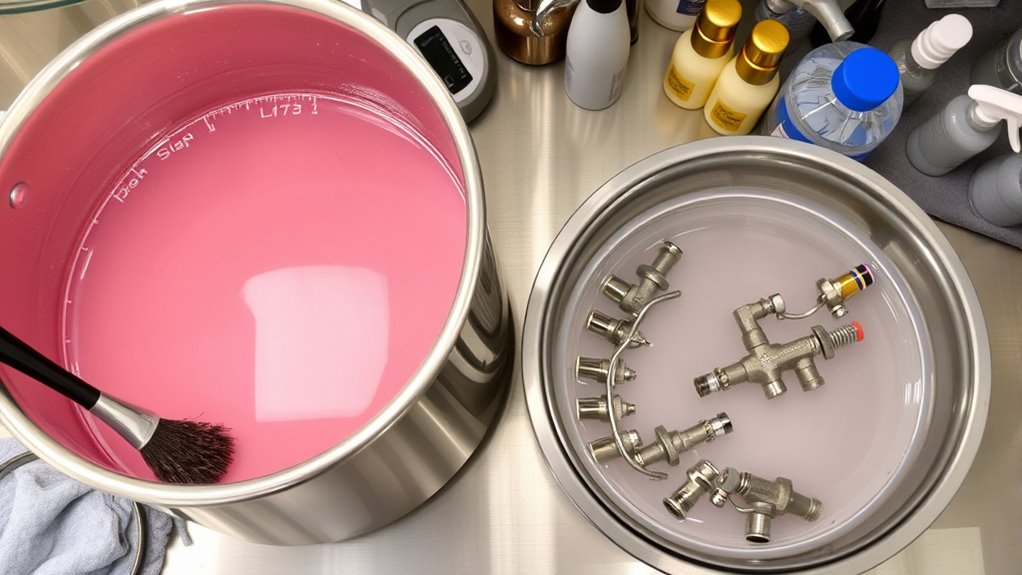
When brewing beer, knowing when to clean and when to sanitize your equipment is essential for preventing contamination and ensuring a successful fermentation.
Start with cleaning to remove visible dirt and residues, which can harbor unwanted microorganisms on the surface. After cleaning, use sanitizing agents to eliminate 99.9% of these microorganisms, creating a safe environment for your brewing process. Essential sanitizer products can greatly aid in this sanitization process.
Begin by cleaning to eliminate visible dirt and residues, then sanitize to ensure a safe brewing environment by removing nearly all microorganisms.
Be particularly vigilant with fermentation types that may attract mold or kahm yeast. Remember to clean equipment immediately after use to prevent residue buildup and contamination risks in future batches. This knowledge will elevate your brewing game considerably.
Helpful Hints:
- Clean before fermentation.
- Sanitize after cleaning.
- Target specific fermentation needs.
- Use appropriate sanitizing agents.
How to Clean Your Equipment
Effective cleaning of your brewing equipment is essential for ensuring a successful beer-making process. Start by removing visible debris with soap and hot water.
Then, regularly clean your equipment using PBW at a dilution of 1-2 oz per gallon to effectively remove organic matter. Rinse thoroughly with potable water to eliminate any residual agents.
Don’t forget to scrub hard-to-reach areas with clean brushes, replacing them as needed. Always clean your equipment immediately after use to maintain a hygienic brewery environment. Neglecting cleaning can lead to biofilm buildup that compromises fermentation consistency and the quality of the final product.
- Use hot, soapy water
- Soak in PBW
- Rinse with potable water
- Scrub with firm brushes
- Clean after each use
How to Sanitize Your Equipment
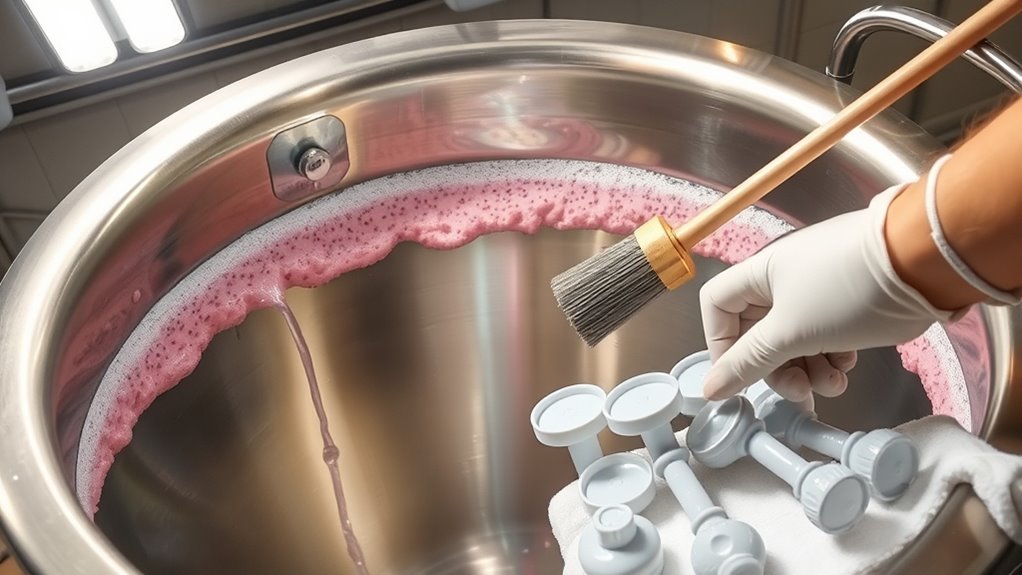
After you’ve thoroughly cleaned your brewing equipment, the next step is to sanitize it to eliminate any lingering microorganisms that could spoil your beer.
Use no-rinse sanitizers like Star San, which only require a brief contact time of 1-2 minutes. For effective sanitation, dilute 1 tablespoon of Star San in 10 liters of cold water, spray it on surfaces, and allow it to air dry.
Remember, sanitizing all equipment that comes into contact with the beer, including fermenters, tubing, and tools, guarantees a clean brewing environment. Regularly monitor your practices to prevent unwanted microorganisms like lactobacillus and wild yeast. Additionally, when sanitizing bottle caps, make sure they are fully submerged in the sanitizer solution for 1-5 minutes to avoid contamination while preserving their sealing integrity.
Helpful Hints:
- Always clean before sanitizing.
- Use sodium carbonate to enhance cleaning.
- Sanitize shortly before use.
Recommended Sanitization Techniques
To guarantee your brewing equipment is properly sanitized, it’s essential to adopt reliable techniques that effectively eliminate harmful microorganisms. Here are some recommended methods:
- Use no-rinse sanitizers like Star San or Iodophor.
- Dilute Star San at 1 tablespoon per 10 liters of cold water, applying it to air dry.
- Maintain a 1-minute exposure for Iodophor at 25 ppm.
- Sanitize equipment immediately before use to prevent microbial contamination.
- Regularly replace worn cleaning tools to avoid introducing contaminants.
Incorporating sodium percarbonate can enhance your sanitization process, ensuring your brewing remains uncontaminated and innovative.
Tools and Products for Effective Cleaning
When it comes to cleaning your brewing equipment, having the right tools and products can make a significant difference in maintaining hygiene and preventing contamination.
Use sturdy brushes with firm bristles to clean effectively, avoiding abrasions. For cleaning agents, PBW (Powdered Brewery Wash) is excellent; dilute 1-2 oz per gallon for ideal results.
Utilize robust brushes with firm bristles for effective cleaning, and dilute PBW at 1-2 oz per gallon for optimal results.
Don’t forget sanitizers like Iodophor, which requires a contact time of 1 minute at 25 ppm, or Star San, a no-rinse option needing 1-2 minutes.
Always rinse equipment thoroughly with potable water after using these cleaning agents to guarantee yeast and beer quality remain intact. Eco-friendly cleaning products can also enhance your cleaning process and reduce environmental impact.
Helpful Hints:
- Replace worn brushes regularly.
- Store all tools in a clean area.
Common Contaminants in Homebrewing
Homebrewing can be a rewarding hobby, but it comes with its own set of challenges, especially concerning contaminants.
Knowing what to look for helps you maintain quality and great flavor. Here are common contaminants to watch out for:
- Wild yeasts like Brettanomyces, which can spoil your brew
- Lactic acid bacteria such as Lactobacillus, which can create sour flavors
- Mold, producing mycotoxins that harm both health and taste
- Residual cleaning agents that can affect yeast and quality
- Physical debris like dirt and hair, leading to cloudiness
Always sanitize your equipment to prevent these issues effectively.
Best Practices for Maintaining Clean Equipment
Maintaining clean equipment is essential for successful homebrewing, as even the smallest contaminants can ruin your batch.
Start by thoroughly cleaning and sanitizing all brewing equipment, including fermenters and bottles, right after use. Use effective no-rinse sanitizers like Star San or Iodophor, which sanitize quickly and eliminate rinse water risks.
Thoroughly clean and sanitize all brewing equipment immediately after use with no-rinse sanitizers like Star San or Iodophor.
When cleaning with PBW, dilute it properly—1-2 oz per gallon—for effective residue-free results. Regularly sanitize surfaces and tools to reduce microbial exposure, and store sanitized equipment in clean, sealed containers to prevent recontamination. Properly sanitized equipment also plays a critical role in preserving beer flavor, as it helps prevent contamination that could spoil your brew.
Following these practices will guarantee your brewing process remains hygienic and innovative.
Helpful Hints:
- Clean immediately after use.
- Use only recommended concentrations.
- Keep storage areas clean.
